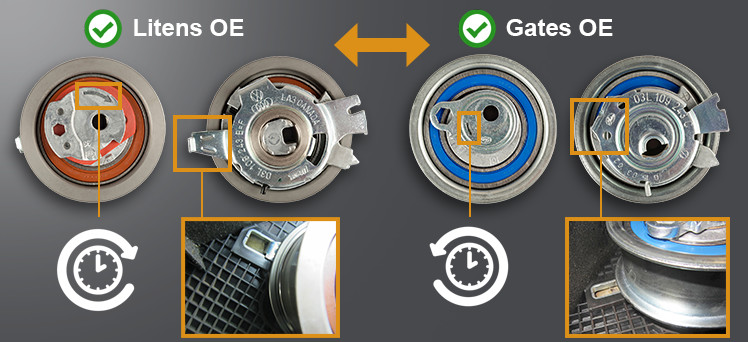The cause of timing belt drive failure can very often be found in errors made during the installation process. As with all primary drive system jobs, the work should be undertaken with the engine cold and the technician should use the proper tools. Additionally, the timing belt replacement procedure can only be completed correctly and safely when keeping strictly to the prescribed installation procedure for the specific application.
ONE INSTALLATION PROCEDURE IS NOT SIMILAR TO ANOTHER
It is dangerous to assume that one timing belt installation procedure is similar to another. Although car manufacturers have models with similar engines,
different engine codes may require a different procedure. Car manufacturers may also use
different sources (part suppliers) for a particular engine part (e.g. to avoid that problems with one supplier would disable the car manufacturer's production). Therefore, it is particularly dangerous to neglect the prescribed installation procedure.
EXAMPLE ON A POPULAR ENGINE (VAG 1.2 1.6 2.0 DIESEL)
As an example, both Gates and Litens are OE on the timing belt tensioner that goes into the VAG 1.2, 1.6 and 2.0 diesel engine. Both tensioners look visually different, but are perfectly interchangeable. The Gates tensioner (part number T43219) differs from the Litens tensioner in that it does not have a retaining lug and is rotated counter clockwise instead of clockwise upon installation.

ROTATION RECOMMENDATIONS
Different tensioners turn in different directions, so you may have to rotate the tensioner clockwise or counter clockwise depending on the specific application.
Turning a tensioner the wrong way will negatively influence tensioner behaviour and cause timing belt drive issues. That’s why Gates recommends that you
always follow its specific installation procedure which can be found in the Gates kit box.
To demonstrate the extent of this issue, rotating the tensioner in the wrong direction during the set-up will cause:
-
Incorrect tensioner position
-
Improper belt tension
Resulting in:
-
Damage to tensioner and/or belt
-
Improper belt tracking causing interference with other components
-
Catastrophic engine damage due to timing belt and other component failure
Always keep strictly to the prescribed timing belt installation procedure and follow the arrow on the tensioner which shows the right direction to put tension on the system!